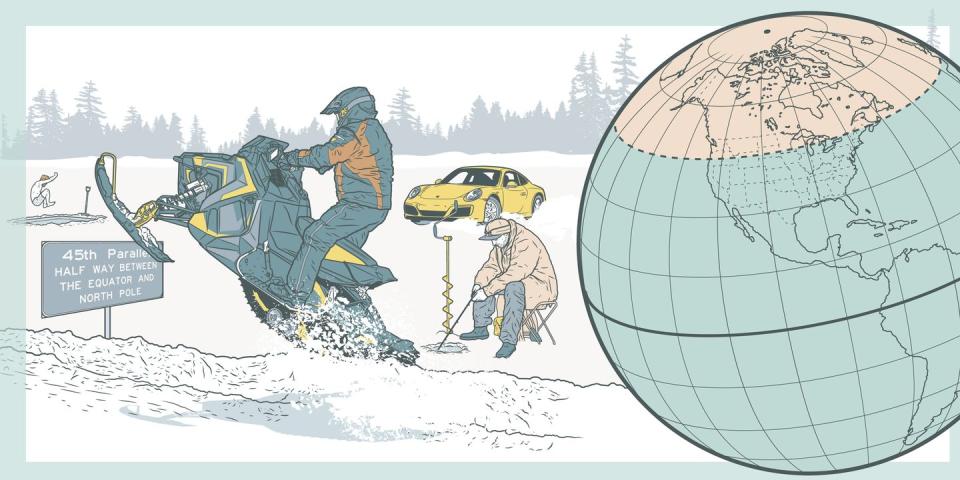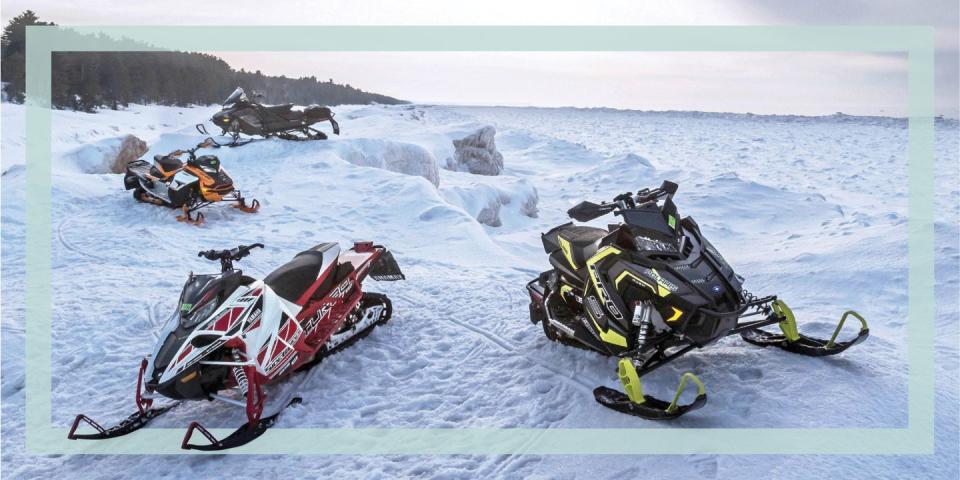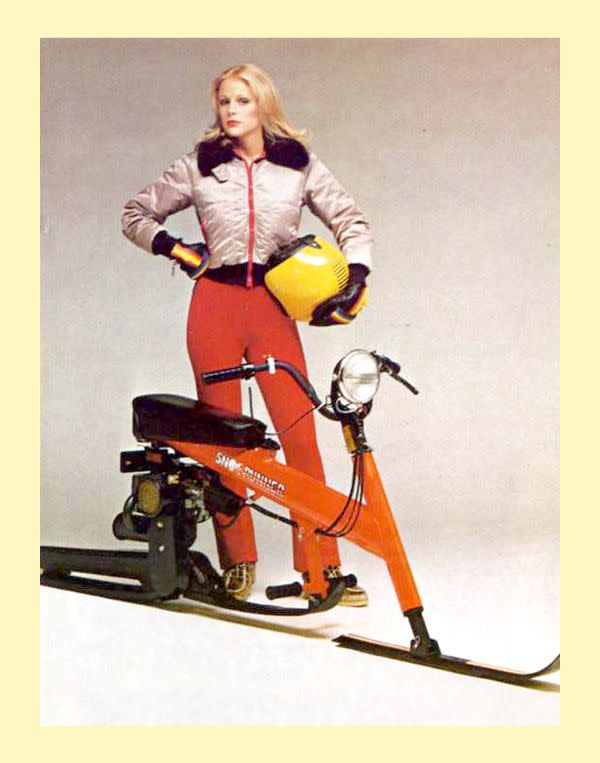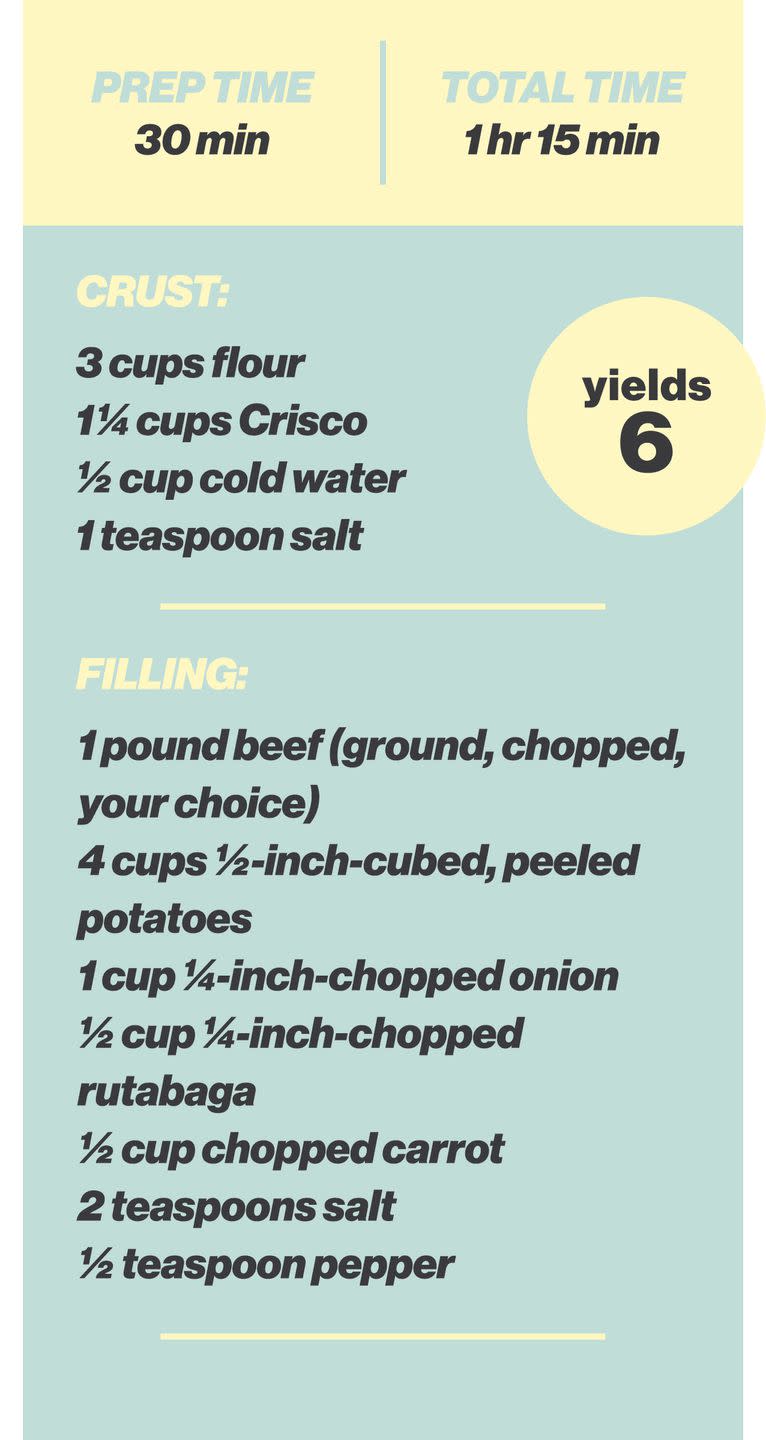The Strange Winter Life in the Icy Far North

Even in the land of ice and snow, life finds a way. Ask your nearest arctic woolly bear caterpillar, which spends much of its life frozen solid. Or ask the woolly humans who live north of the 45th parallel-that is, they live closer to the North Pole than to the equator. They not only survive decades of deeply uncomfortable, face-blistering cold (through liberal use of saunas, alcohol, hot meat pies, engine-block heaters, and alcohol), but they find ways to actually enjoy their habitat. Upon great sheets of frozen water, they ride machines powered by fiery explosions. This is their story. Valhalla, they are coming!
We Test the Baddest Snowmobiles from Polaris, Ski-Doo, and Yamaha

Yeah, winter can be a drag. We gauge the temperature by how fast snot turns from goo to solid ice even though it's still in our nostrils. Months spent hibernating indoors watching SCTV reruns, only emerging periodically to shovel snow, will wear a person down. But anyone who thinks winter sucks probably doesn't own a snowmobile. Read More
Proper Attire is Key
Winter is more enjoyable when you can keep warm. Air hitting your skin at 100 mph and the consequent skin-cell death will ruin your day. But you don't have to dress like Randy Parker (Ralphie's little brother) to survive snowmobiling. We never would've imagined we'd be standing on an iceberg and complaining about being too hot, but that was exactly our experience during our photo shoot. Outfitter Klim's riding gear offers superior lightweight protection from wind and subzero temperatures. And as our novices learned how important it is to be able to easily move about atop the sleds, we appreciated the lack of bulk in Klim's jackets, bibs, and boots. Pro tip: If you wear glasses, go for a full-face helmet. Goggles and glasses don't mix.
How They Clear the Snow

Emmitt M. Tucker registered the Sno-Cat trademark in 1944, and over the nearly 75 years since, the Tucker Sno-Cat Corporation of Medford, Oregon, has built some 8000 to 10,000 over-snow vehicles.
Its current best seller is the Model 2000, which has a base price of $195,000. It's a rear-engined, body-on-frame vehicle that weighs between 11,000 and 13,200 pounds. It's available with two- and five-seat cabs. Most Sno-Cats are used for snowmobile- and ski-trail maintenance, during which they tow grooming sleds. But the company sells models outfitted for utility companies, the military, and even private owners, such as Scatman Crothers.
Power comes from a Cummins turbo-diesel 6.7-liter inline-six that makes 173 horsepower and 590 pound-feet of torque. It's mated to a five-speed Allison automatic transmission. A 300-hp, 760-lb-ft version is also available. A custom transfer case sends torque to both axles at all times. Top speed is about 20 mph.
Dana Spicer 80 axles with ARB air lockers are suspended front and rear by leaf springs. The axles swivel in opposite directions via fifth-wheel assemblies to allow for a tight turning circle of just 44 feet. Custom hubs bolt to drive sprockets that rotate within the track carrier, which is mounted to the differential. The tracks themselves are similar to those used by snowmobiles and allow a Sno-Cat to climb a 100 percent grade. Get yourself one for Christmas.
Winter-Testing Cars Is an Isolated Life That Quickly Gets Weird

The worst part isn't the cold-although it's plenty cold in Baudette, Minnesota, a stone's throw from the Canadian border. During the month of January, the average low is minus 7 degrees Fahrenheit, and the thermometer makes regular dives to 30 below. It's so cold that people don't turn their cars off when running errands for fear they won't restart. Read More
Chrysler Once Tried to Sell a Snow Bike

Before focusing primarily on putting ever-more-powerful V-8s into old rear-drive chassis, the company formerly known as Chrysler tried to entice northerners into its showrooms with a snowbound moped called the Sno-Runner. With one large frame member, the Sno-Runner looked like a Honda Mini Trail bike but with a ski in place of the front wheel and a narrow track replacing the rear one. It was collapsible, too, so you could fit it easily into the cargo hold of your Dodge Omni 024. With a 134-cc two-stroke engine mounted beneath the seat, the near-$700 Sno-Runner didn't so much run as it trundled. Disparagingly referred to as Slo-Runners, they were effectively useless at altitude or in deep snow and didn't pay off on the advertising promise: "A super-sizzling, ultra-new winter thing to do." Having larger fish to fry, Chrysler gave up on the Sno-Runner in 1981 after a three-year run.
We Put Snow Tires on a Corvette and Porsche to See How They Handle Snowy Roads

To those of us who endure Michigan winters, with their coatings of dirty slush and skies the color of raw aluminum, the harbingers of spring are keenly cataloged. In grade school, we were taught to be on the lookout for the return of that prodigal son of the avian world, the robin. To the frostbit and vitamin D deficient, the presence of the orange-breasted bird inspires hope that light and warmth will indeed return eventually. Read More
Northerner Hat-Wearing Advice and Lingo
Despite what your uncle Ron told you, Eskimoan languages do not have 100 words for snow. But there are nearly that many words in northerners' English for a knit cap. "Beanie" is not one of them; that's the thing nimrods wear at Starbucks when it's warm outside. No, a real knit cap is called a toque or a tuque or a chook or a chuke or, sure, a stocking cap. It is the single most critical element of winter apparel. Here are the rules: Do we even need to tell you that it should be knit of wool? Further, it must be large enough to fully cover your ears, lest you want to be called Lefty for the rest of your life. For maximum Bob and Doug McKenzie effect, you might choose a pointed version with a colorful pompom attached. You may not choose one of those slouchy affairs that sags off the back of your melon unless your job is crafting high-end beard combs.
What the Locals Eat

Cultural hegemony has made it north-pizza and burgers are now the caloric common denominators of the entire American landscape. But in the northern reaches, some traditional regional delicacies do survive to comfort the locals and confound-nay, disgust-visitors.
Pasties: The North's version of an empanada, a potsticker, or any other Hot Pockets–like, purse-shaped pastry filled with scalding-hot stuff. In this case, it's filled with what is basically a traditional meat-and-potatoes dinner. Pasties are one of the few uses for rutabagas. And it's pronounced pass-tee, so save yourself the joke.
Traditional Yooper Pasties
Instructions:

1. Mix the flour and salt in a large bowl. Cut in the Crisco with a pastry blender until mixture resembles pea-size crumbs. Add the water all at once and mix until you have a clump of dough. If it's too moist, add a bit of flour until it's pliable and soft.
2. In another large bowl, mix by hand all the chopped vegetables, meat, salt, and pepper.
3. Roll out fist-sized chunks of dough into ovals, about ¼-inch thick.
4. Place 1 cup of uncooked filling on one side of each dough oval.
5. Fold the dough over the filling and crimp the edge.
6. Place on a cookie sheet and bake at 375 degrees for 45 to 50 minutes.
7. Apply ketchup liberally.
Recipe and photograph courtesy of TheYooperGirl.com
Other Traditional Northern Favorites
Fried Perch: They don't need to be caught in an ice-fishing shanty, but they probably will have been.
Whitefish: Beer-battered, broiled, or baked.
Whitefish Spread: Mmmm, spreadable fish! Smoked whitefish with mayo, sour cream, and herbs.
Whitefish Sausage: Like other sausage, but made with fish!
Lutefisk: Traditional Scandinavian dish of whitefish treated with lye. It's gelatinous fish! To be eaten only on a dare.
Beer: Beer.
Cheese Curds: Moist pieces of curdled milk. Also called "squeaky cheese" because of the sound they make when bitten. A staple of Wisconsin, where they are sometimes battered and deep-fried to make sort of proto–cheese sticks.
Booyah: A stew typically prepared in large quantities with no set ingredients. Booyah!
Cudighi: Italian pork sausage that, improbable as it might seem, has become popular in Michigan's Upper Peninsula. Served on sandwiches, pizza, and spaghetti.
('You Might Also Like',)

 Yahoo Finance
Yahoo Finance 